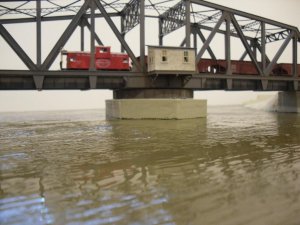Jim 68cuda
Well-Known Member
At some point this winter, I expect to be ready to model water on my layout. It will be a rocky shoreline of a bay. I've read several different methods for doing water from painting directly on wood (or even painted plaster) covered with tinted gloss medium, to using Magic Water, or Woodland Scenics water products over paint, or in several layers over a detailed stream bed.
I've been thinking of a slight twist on what i've read, and would like to hear some input. The water I model will be rather deep. I want to simulate some depth.
I'm thinking of using some clear plexiglass. Then, rather than painting the top surface as you would if you were preparing wood or plaster prior to applying your "wet" top coat, I would paint the bottom of the plexiglass. Then, I thought the top of the plexiglass could be painted with more transluscent tones, but more opaque in some areas than others (thus it would be possible to hide the thickness of the plexiglass at the shoreline). I could drill holes in the plexiglass for wood piers to a dock so it looks like the piers actually disappear into the water. On top of the plexiglass, I would use Woodland Scenics water or Magic water or one of the other methods for creating ripples and small waves.
Am I over thinking this, or could this actually work for creating the appearance of more depth than the the more traditional ways of making water? I don't want it to look blotchy or cloudy and I don't want it to look like the water is only as deep as the plexiglass is thick. Has anyone tried anything like this?
I've been thinking of a slight twist on what i've read, and would like to hear some input. The water I model will be rather deep. I want to simulate some depth.
I'm thinking of using some clear plexiglass. Then, rather than painting the top surface as you would if you were preparing wood or plaster prior to applying your "wet" top coat, I would paint the bottom of the plexiglass. Then, I thought the top of the plexiglass could be painted with more transluscent tones, but more opaque in some areas than others (thus it would be possible to hide the thickness of the plexiglass at the shoreline). I could drill holes in the plexiglass for wood piers to a dock so it looks like the piers actually disappear into the water. On top of the plexiglass, I would use Woodland Scenics water or Magic water or one of the other methods for creating ripples and small waves.
Am I over thinking this, or could this actually work for creating the appearance of more depth than the the more traditional ways of making water? I don't want it to look blotchy or cloudy and I don't want it to look like the water is only as deep as the plexiglass is thick. Has anyone tried anything like this?


